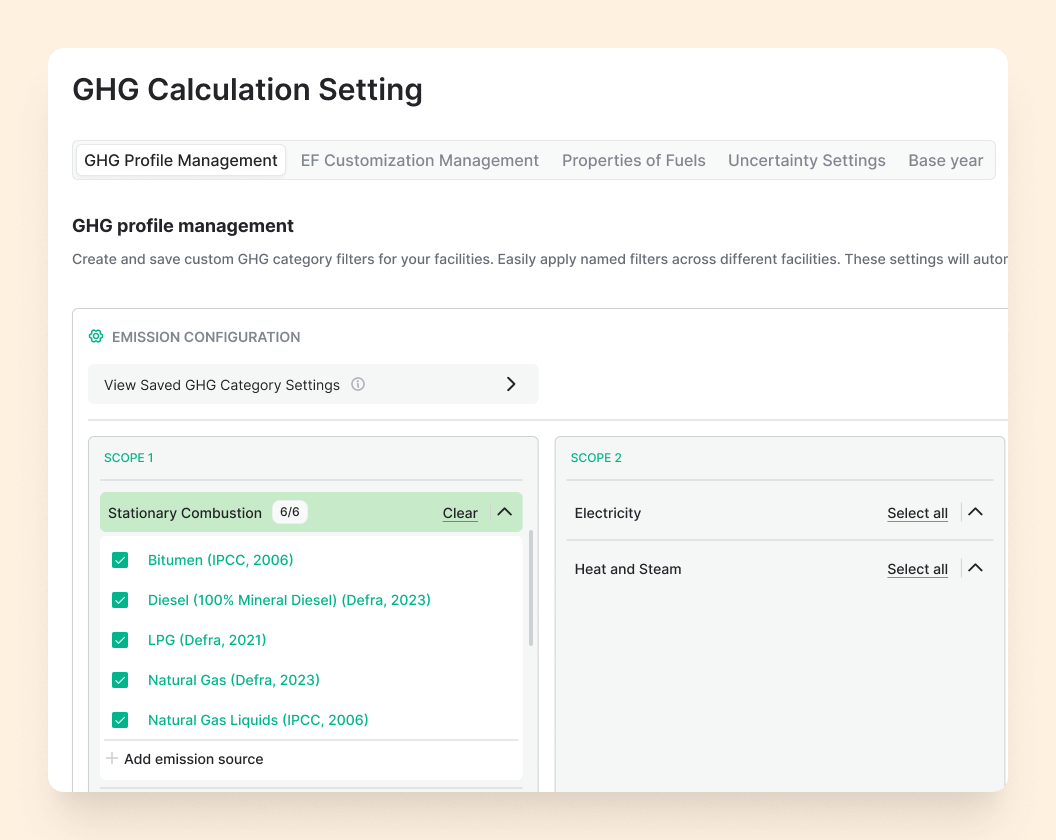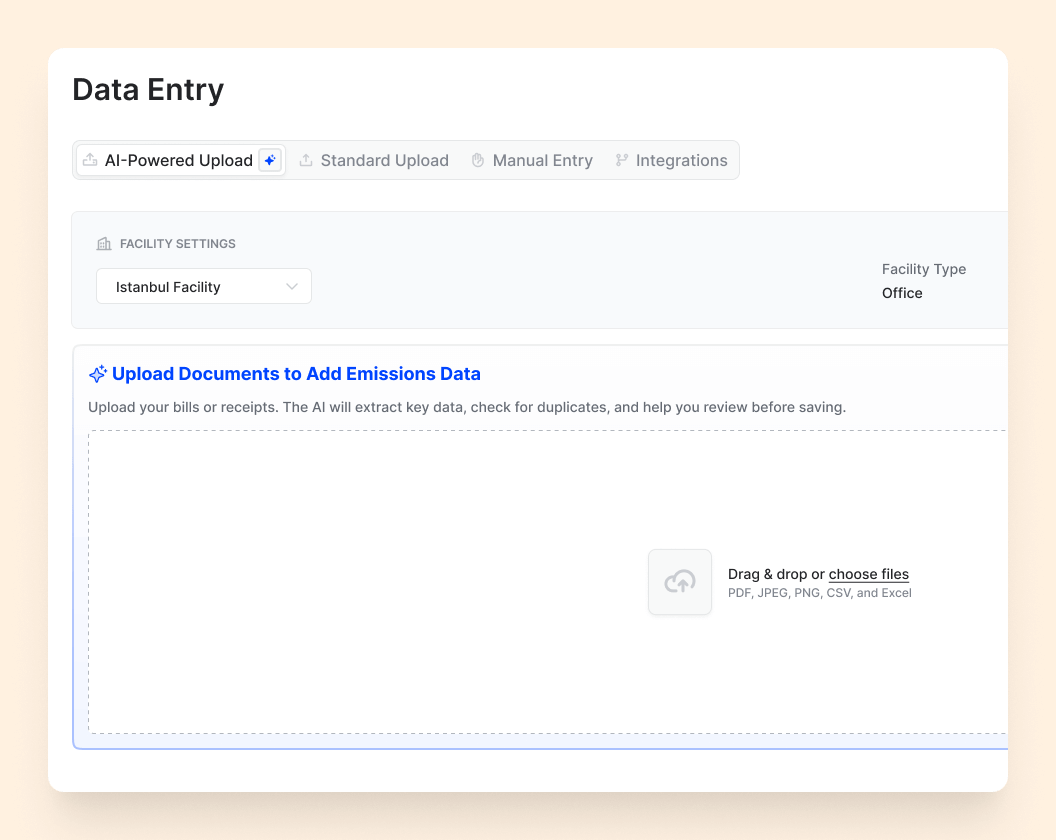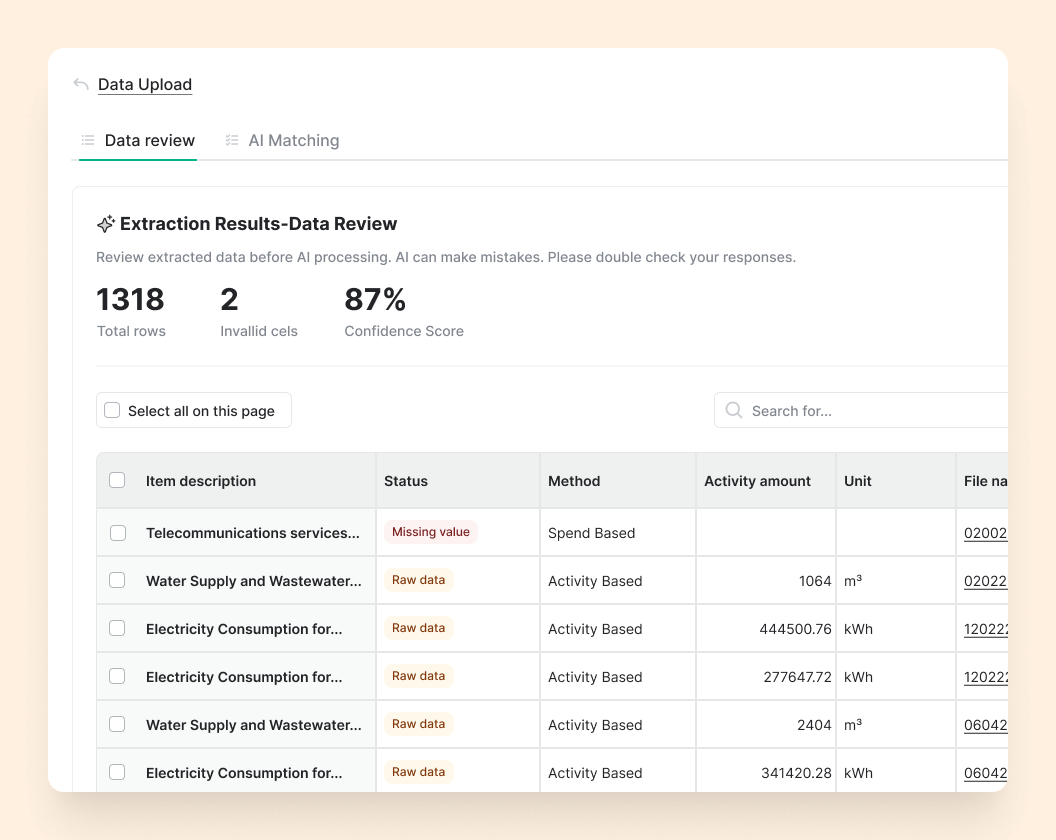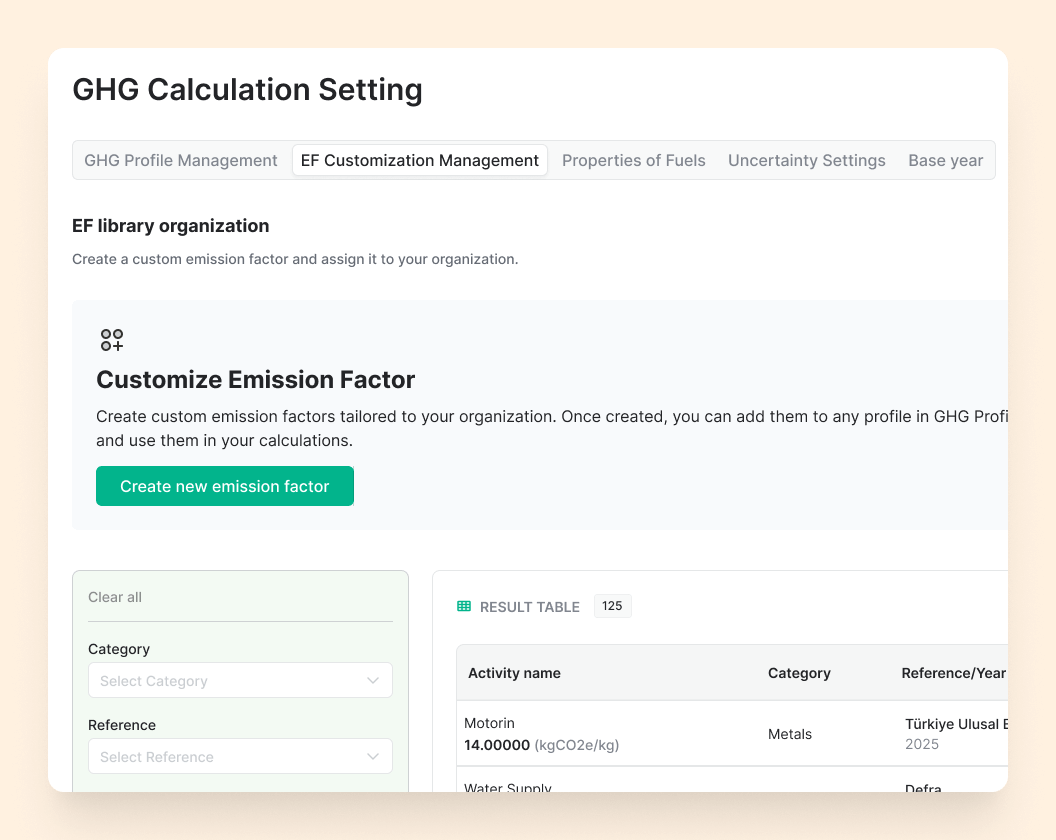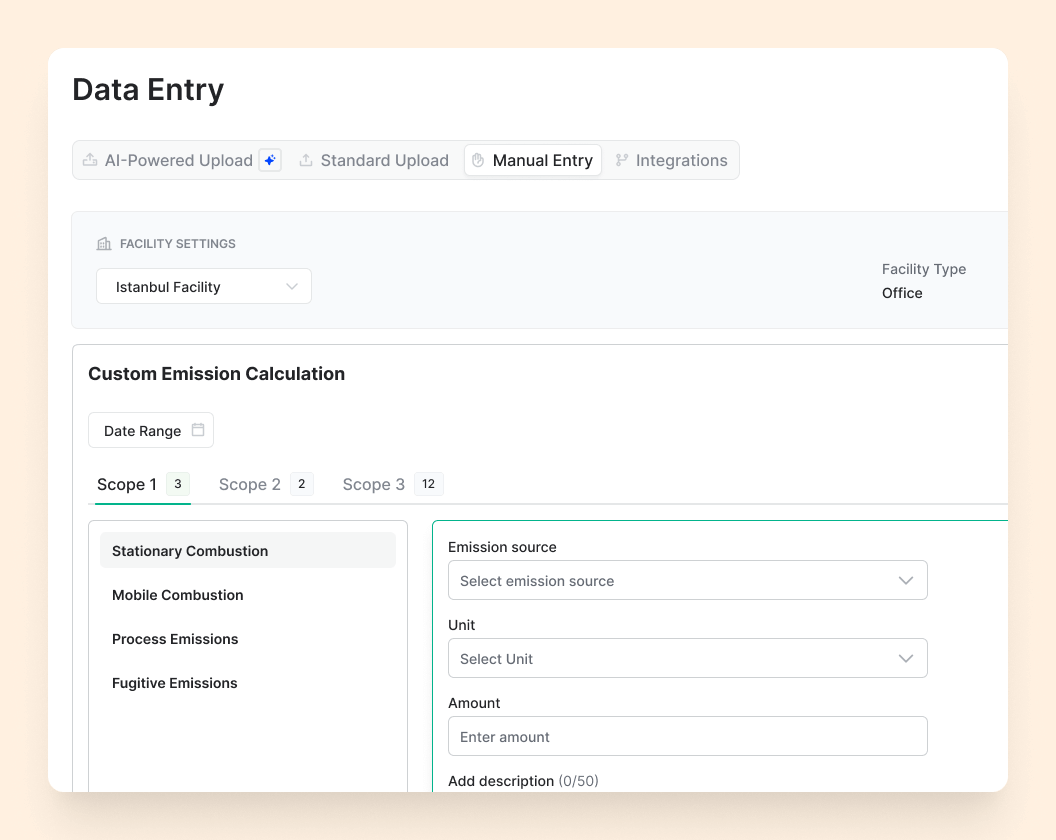Start Calculating
Fastest Way to Get Emission Results
Drop a File or Sync Your System
Just upload invoices or integrate with your accounting system, and let your AI Agent teammate read your document, extract the data, map it to the right emission sources, and select the emission factors.
Upload Your First DocumentBuilt for Teams Who Do Sustainability Right
Save Hours From Day One
With AI-powered Upload, Data Coordinator Agent reads your PDFs, invoices, and spreadsheets instantly — no formatting or manual entry needed.
Ensure Audit-Readiness from the First Upload
Every data point is traceable, and every number is backed by a source. No missing info, no red flags. Your team — and your auditor — will thank you.
Know You’re Doing It Right
Guided forms, built-in data validation, and emission factor libraries make sure your numbers are credible. Climate Analyst Agent automatically matches the right factors to the right data.
FAQ
What is a carbon footprint and how is it calculated?
A carbon footprint is the total amount of greenhouse gases (GHGs) emitted directly and indirectly by an organization, product, or activity — expressed in CO2e equivalents (CO2e). It includes emissions from energy use, transportation, purchased goods, business travel, and more.
Carbon footprints are calculated by identifying emission sources, gathering activity data (e.g. fuel use, electricity consumption, supplier purchases), and applying standardized emission factors. Frameworks like the GHG Protocol provide the structure for categorizing emissions into Scope 1 (direct), Scope 2 (indirect energy), and Scope 3 (value chain) categories.
Carbondeck automates this process by extracting data from invoices, spreadsheets, and documents, then matching it to the related emission factors — making footprint calculation faster, more accurate, and audit ready.
How accurate are Carbondeck’s GHG calculations? And how is this ensured?
Carbondeck delivers high-precision GHG calculations built on years of consultancy expertise and industry-aligned methodology.
We ensure accuracy through:
- Complete scope coverage across Scope 1, 2, and 3
- 500,000+ emission factors from globally recognized databases, updated regularly
- Custom EF support, so you can reflect specific operations or supplier data
- Tier Quality ratings to assess data confidence and reliability
- Best-practice methodologies, aligned with GHG Protocol and ISO 14064 standards
From input to output, every number in Carbondeck is traceable, explainable, and audit ready.
How do I input data for Scope 1, 2, and 3 calculations?
Carbondeck offers multiple data entry options tailored to each plan. Here's how it works across different plans:
Free Plan: Data is entered manually using guided forms. Users select a standard, define emission sources, and enter activity data step by step.
Booster Plan: Includes Free Plan method, plus bulk entry via Excel and data collection templates for faster, standardized input across larger datasets.
AI Agents Plan: No manual input required. The Data Coordinator Agent automatically extracts and maps data from uploaded invoices, spreadsheets, and PDFs — enabling instant, audit ready entries.
Enterprise Plan: Custom-configured. By default, supports manual and bulk methods. AI-powered data input is optional and can be added based on enterprise needs.
For detailed, plan-specific instructions and walkthroughs, please visit User Guide available on the platform. It includes step-by-step tutorials and best practices to help you input data accurately and efficiently.
How can I customize emission factors in Carbondeck? And what is the benefit of this feature to my calculation?
Emission factor (EF) customization is available in Booster, AI Agents, and Enterprise plans — allowing you to tailor calculations to reflect specific suppliers, regions, or operational details. This is essential for improving the accuracy and credibility of your GHG inventory, especially if you operate in regulated sectors or have unique emission sources.
- In Booster Plan, you can manually define custom EFs using the EF Customization Form. You'll enter details like activity name, source, year, region, unit, scope, and uncertainty — and assign them to specific facilities and emission categories.
- In AI Agents Plan, EF matching is largely automated: the Climate Analyst Agent selects the most appropriate factor from a database of over 500,000 entries. However, you can still define and prioritize your own custom factors when supplier-specific or internal data is available.
- In Enterprise Plan, all customization features are supported, with the added benefit of onboarding assistance and configuration support. This allows complex organizations to apply internal methodologies or custom validation logic if needed.
Custom EFs give you full control over how emissions are calculated — ensuring traceability, sector alignment, and compatibility with local regulations or audit requirements.
For step-by-step setup instructions, visit our User Guide.
How does the Emission Factor Library work? Which databases are included?
Carbondeck’s Emission Factor (EF) Library gives you access to over 500,000 emission factors from the world’s most trusted sources — enabling precise, up-to-date, and standards-aligned calculations.
Here’s how it works:
- Carbondeck’s EF engine offers access to a vast library of EFs from multiple reputable databases.
- EFs in the library are updated swiftly as the original databases release new versions.
-
Users can perform their calculations by selecting the EFs they need from a variety of sources, including:
- → DEFRA (Department for Environment, Food & Rural Affairs)
- → IPCC (Intergovernmental Panel on Climate Change)
- → Ecoinvent
- → EPA (Environmental Protection Agency)
- → EEA
- → Base Carbone™ (ADEME)
- → CBAM
- → GLEC
- → EXIOBASE
- → EIME (Environmental Improvement Made Easy)
- → Australian National Life Cycle Inventory Database (AusLCI)
- → ProBas (Prozessorientierte Basisdaten fϋr Umweltmanagement-Instrumente)
- → 3EID
- → BUWAL
- → Environmental Product Declarations (EPD)
- → Canadian Raw Materials Database
- → CEDA
- → Building Research Establishment
- → Carbon Calculations over the Life Cycle of Industrial Activities (CCaLC)
- → ESU-services (extension of ecoinvent 2.2)
- → European Container Glass Association (CGA)
- → European Copper Institute (ECI)
- → European Federation of Corrugated Board Manufacturers (FEFCO)
- → Global Emission Model for Integrated Systems (GEMIS)
- → Greenhouse gases, Regulated Emissions, and Energy use in Transportation (GREET)
- → Biomass Environmental Assessment Tool (BEAT)
- → Inventory Database for Environmental Analysis (IDEA)
- → Sustainable Recycling Industries – Life cycle Inventories project datasets and tools
- → Swiss Agricultural Life Cycle Assessment (SALCA)
- → International Energy Agency (IEA) GHG Programme
Carbondeck also supports custom emission factors, allowing organizations to reflect region-specific, supplier-specific, or operational data in their calculations. This ensures higher accuracy and relevance for specialized use cases or regulatory compliance.
Have more questions? Visit Carbondeck Help Center.



